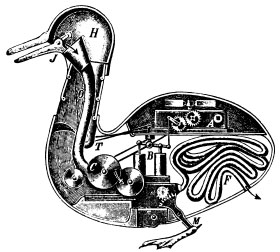
Digesting Duck
Encyclopedia

Automaton
An automaton is a self-operating machine. The word is sometimes used to describe a robot, more specifically an autonomous robot. An alternative spelling, now obsolete, is automation.-Etymology:...
in the form of a duck
Duck
Duck is the common name for a large number of species in the Anatidae family of birds, which also includes swans and geese. The ducks are divided among several subfamilies in the Anatidae family; they do not represent a monophyletic group but a form taxon, since swans and geese are not considered...
, created by Jacques de Vaucanson
Jacques de Vaucanson
Jacques de Vaucanson was a French inventor and artist who was responsible for the creation of impressive and innovative automata and machines such as the first completely automated loom.-Early life:...
in 1739. The mechanical duck appeared to have the ability to eat kernels of grain, and to metabolize and defecate them. While the duck did not actually have the ability to do this - the food was collected in one inner container, and the pre-stored feces was 'produced' from a second, so that no actual digestion took place - Vaucanson hoped that a truly digesting automaton could one day be designed.
Voltaire
Voltaire
François-Marie Arouet , better known by the pen name Voltaire , was a French Enlightenment writer, historian and philosopher famous for his wit and for his advocacy of civil liberties, including freedom of religion, free trade and separation of church and state...
wrote that "without...the duck of Vaucanson, you will have nothing to remind you of the glory of France
France
The French Republic , The French Republic , The French Republic , (commonly known as France , is a unitary semi-presidential republic in Western Europe with several overseas territories and islands located on other continents and in the Indian, Pacific, and Atlantic oceans. Metropolitan France...
." ("Sans...le canard de Vaucanson vous n'auriez rien qui fit ressouvenir de la gloire de la France.")
Modern presence
A replica of Vaucanson's mechanical duck, created by Frédéric Vidoni, is part of the numerous works of art exhibited in the Museum of Automatons in Grenoble, France.The duck is mentioned as the hero of Nathaniel Hawthorne
Nathaniel Hawthorne
Nathaniel Hawthorne was an American novelist and short story writer.Nathaniel Hawthorne was born in 1804 in the city of Salem, Massachusetts to Nathaniel Hathorne and the former Elizabeth Clarke Manning. His ancestors include John Hathorne, a judge during the Salem Witch Trials...
's short story
Short story
A short story is a work of fiction that is usually written in prose, often in narrative format. This format tends to be more pointed than longer works of fiction, such as novellas and novels. Short story definitions based on length differ somewhat, even among professional writers, in part because...
"The Artist of the Beautiful."
A fictitious enhancement of Vaucanson's original duck figures prominently in Thomas Pynchon
Thomas Pynchon
Thomas Ruggles Pynchon, Jr. is an American novelist. For his most praised novel, Gravity's Rainbow, Pynchon received the National Book Award, and is regularly cited as a contender for the Nobel Prize in Literature...
's historical novel Mason & Dixon
Mason & Dixon
Mason & Dixon is a postmodernist novel by American author Thomas Pynchon published in 1997. It centers on the collaboration of the historical Charles Mason and Jeremiah Dixon in their astronomical and surveying exploits in Cape Colony, Saint Helena, Great Britain and along the Mason-Dixon line in...
.
The duck is used as the symbol for the software company Automatic Duck, Inc.
A replica of the duck was commissioned privately from David Secrett, an automaton maker known for his archer figure.
In 2006, Belgian Conceptual Artist Wim Delvoye
Wim Delvoye
Wim Delvoye is a Belgian neo-conceptual artist known for his inventive and often shocking projects. Much of his work is focused on the body. He repeatedly links the attractive with the repulsive, creating work that holds within it inherent contradictions- one does not know whether to stare, be...
introduced the world to his "Cloaca Machine", a mechanical art work that actually digests food and turns it into excrement, finally fulfilling Vaucanson's wish for a working digestive automation. Many iterations of the Cloaca Machine have since been produced; the current iteration sits vertically, mimicking the human digestive system. The excrement produced by the machine is vacuum-sealed in Cloaca-branded bags and sold to art collectors and dealers; every series of excrements produced has sold out.
Further reading
- Riskin, Jessica. "The defecating duck, or, the ambiguous origins of artificial life." Critical Inquiry 29, no. 4 (2003): 599-633.
External links
- Living Dolls: A Magical History Of The Quest For Mechanical Life by Gaby Wood Guardian Unlimited Books, Extracts, Saturday February 16, 2002
- "A Zenith" by Sara Roberts

